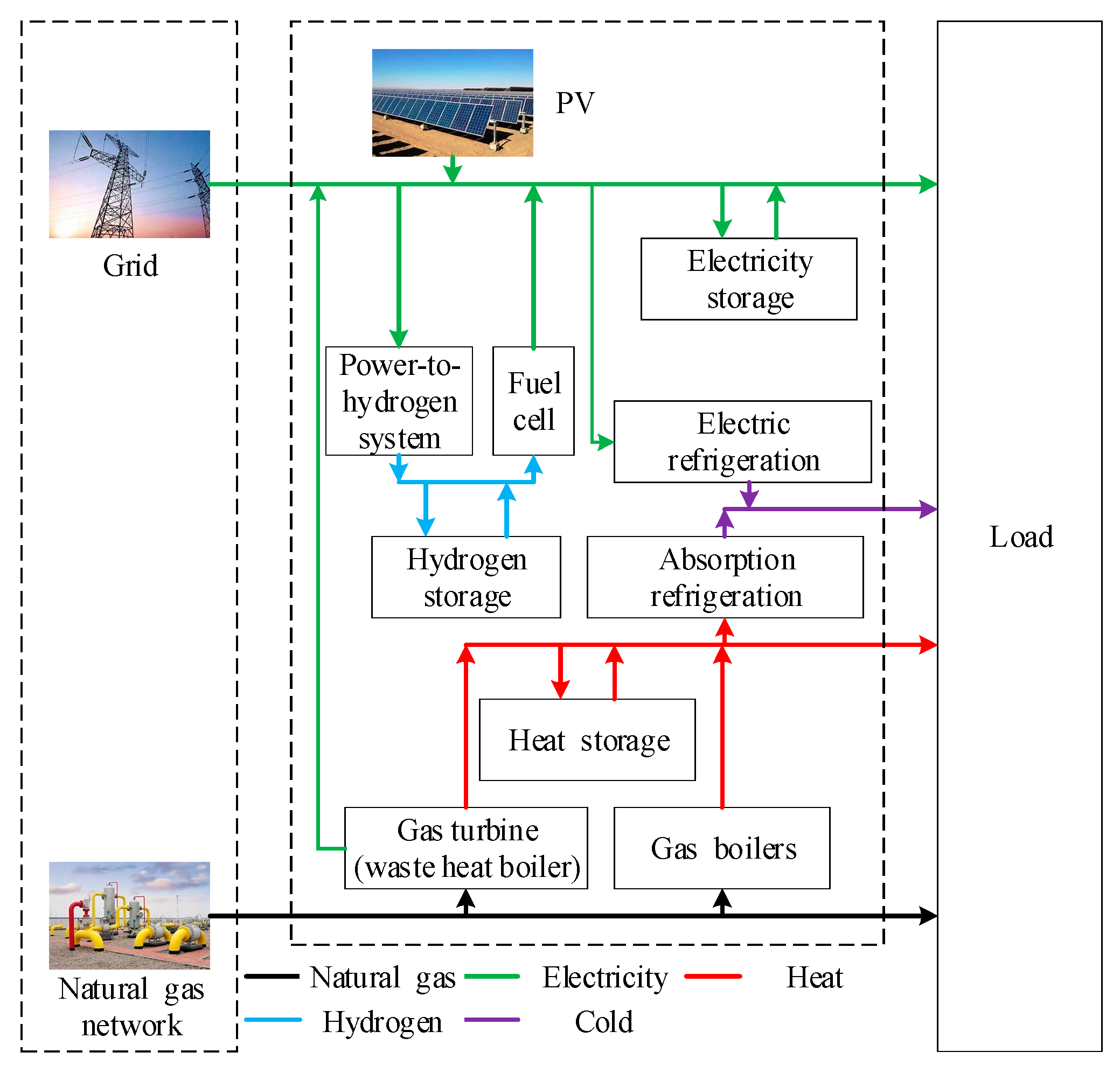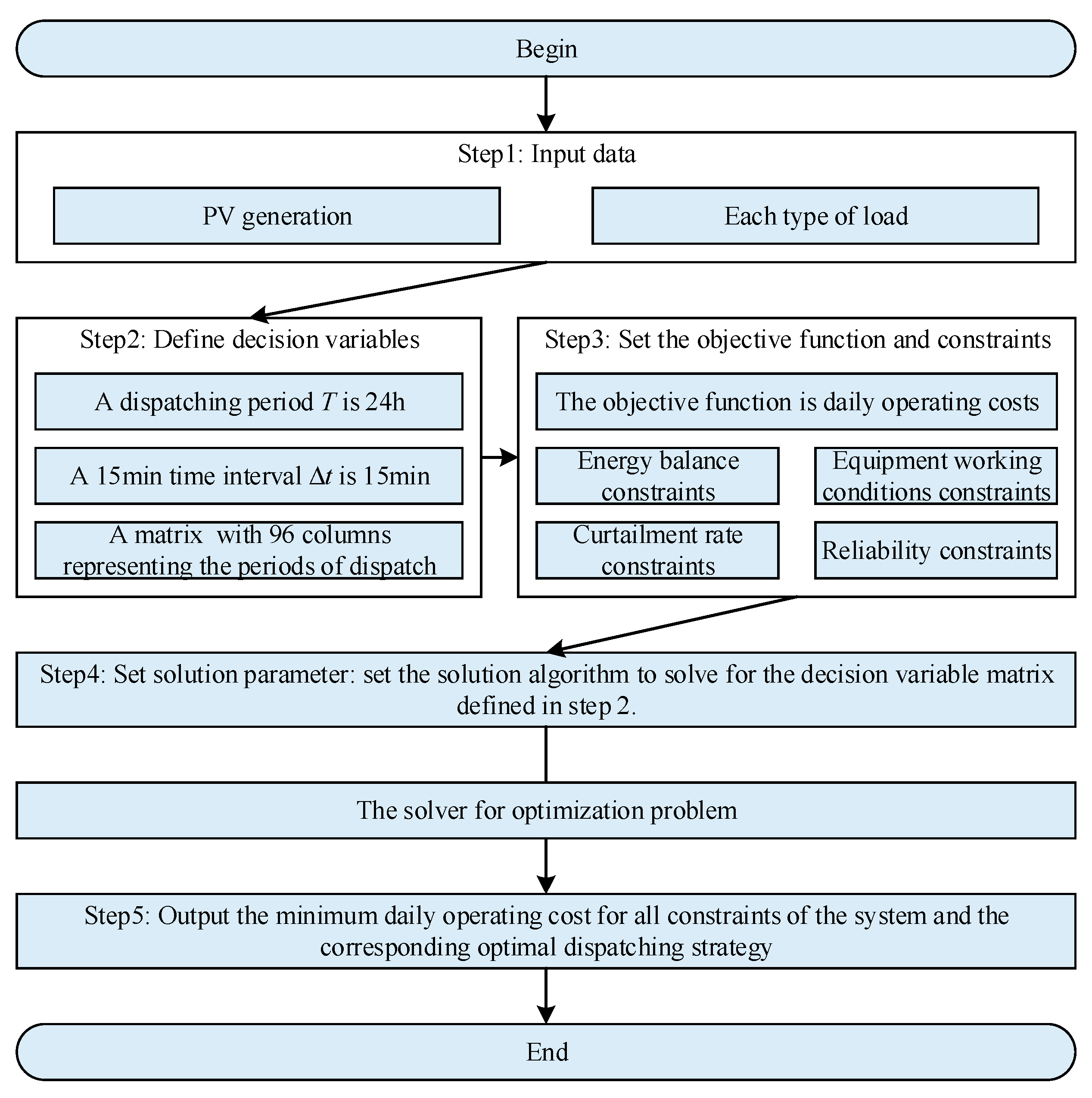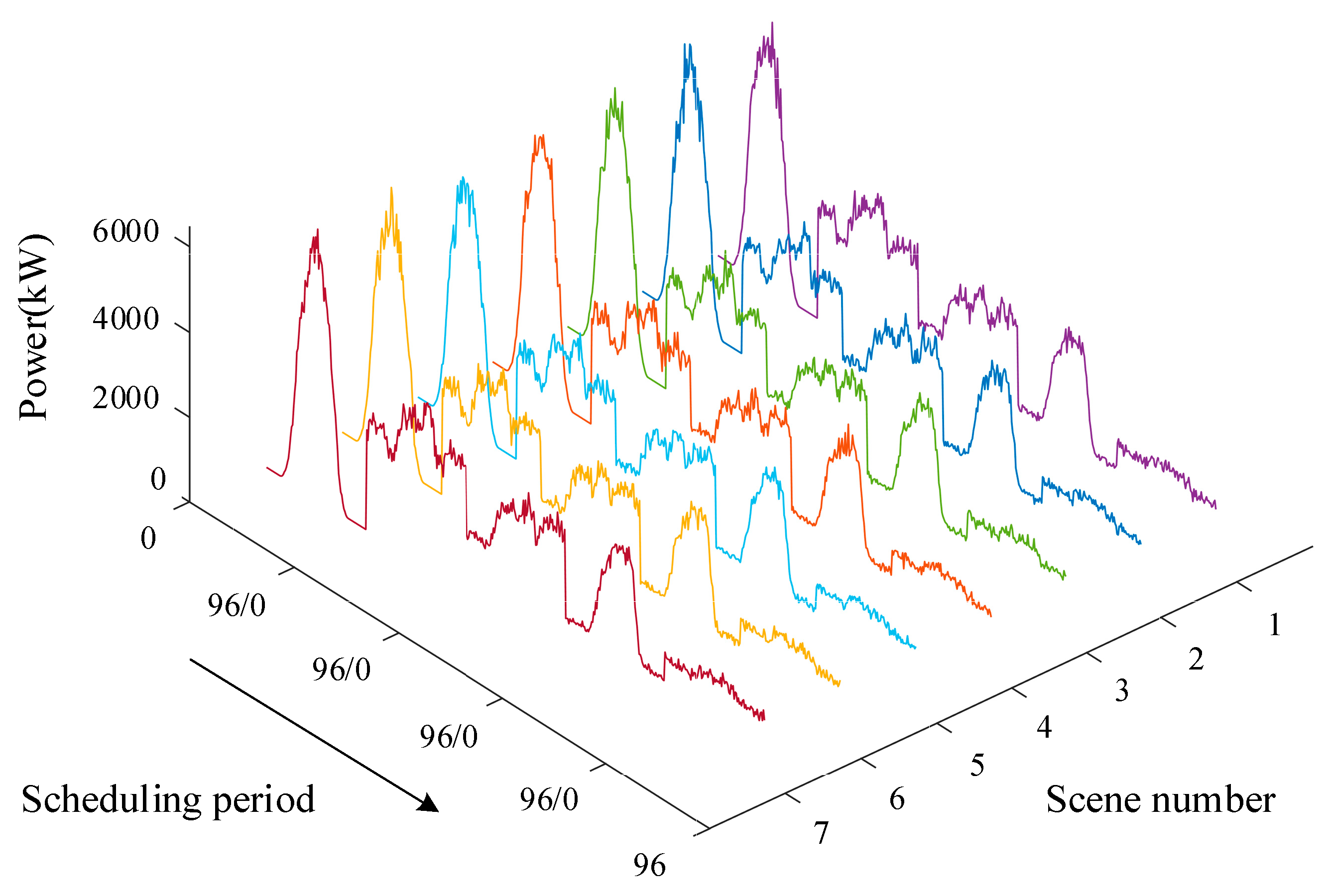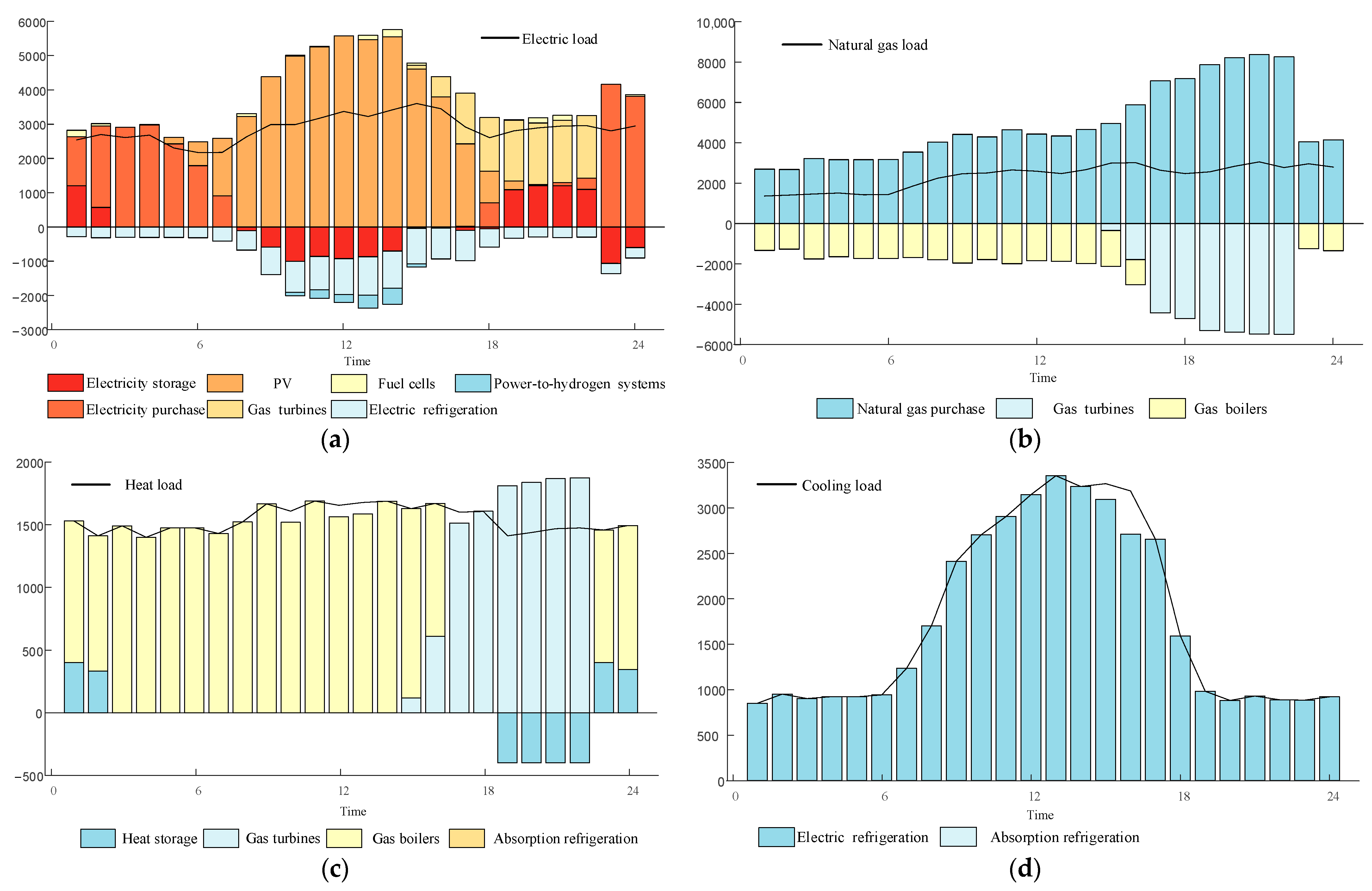Chance-Constrained Dispatching of Integrated Energy Systems Considering Source–Load Uncertainty and Photovoltaic Absorption
Abstract
:1. Introduction
- 1.
- A mathematical model of an IES at the community level was developed. The integrated electricity–heat–cooling–gas–hydrogen energy system was modeled, and a mathematical model was constructed to support optimal collaborative dispatch.
- 2.
- The source–load uncertainty is characterized. Uncertainty models for distributed photovoltaic (PV) output and load demand are developed. Typical scenario datasets are generated by Monte Carlo simulation and K-means clustering, which summarizes the uncertainty characteristics of distributed PV output and load demand and effectively covers possible scenarios. The fuzzy parameters for each cluster are computed to obtain more accurate volatility prediction results.
- 3.
- We adopt the chance constraints to convert an optimization problem containing uncertain variables into a mixed integer linear programming problem, reducing its difficulty in solving. The fuzzy variables of distributed PV output and electric, heat, cooling, and natural gas loads are represented by fuzzy affiliation functions. Then, the uncertain constraints are converted into deterministic constraints using the clear equivalence class method, and finally, the CPLEX solver is invoked to solve the problem.
- 4.
- A collaborative optimization model for IESs is constructed. Optimization is done to minimize daily operating costs, including energy consumption, equipment operation, and maintenance costs. Additionally, considering the segmented curtailment penalty costs, the system can maximize the use of distributed PV and promote the local absorption of new energy while satisfying the economy.
2. Model of IES
2.1. Analysis of IES
- Energy supply includes a power grid, natural gas network, and PV, through which energy can be provided to the IES.
- Energy conversion equipment includes gas turbines and waste heat boilers, gas boilers, absorption refrigeration, electric refrigeration, power-to-hydrogen systems, and fuel cells, through which energy conversion is allowed so that one form of energy converts to another and meets the energy needs of IES.
- Energy storage equipment includes electricity storage, heat storage, and hydrogen storage. By using energy storage equipment, it is possible to transfer energy usage over time and increase the efficiency of energy consumption.
- Loads include electric, heat, cooling, and gas loads. They are the energy-using units of the IES.
2.2. Model of IES Equipment
2.2.1. Energy Supply
- 1.
- Pipe network for energy purchase
- 2.
- PV
2.2.2. Energy Conversion Equipment
- 1.
- Gas turbines and waste heat boilers
- 2.
- Gas boilers
- 3.
- Absorption refrigeration
- 4.
- Electric refrigeration
- 5.
- Power-to-hydrogen system
- 6.
- Fuel cells
2.2.3. Energy Storage Equipment
3. Model of Source–Load Uncertainty
3.1. Source–Load Prediction Error Uncertainty Model
3.2. Source–Load Uncertainty Scenario Set Generation
| Alogorithm 1. The processing of the K-means clustering algorithm. |
|
4. IES Optimization Dispatching Model
4.1. Objective Function
4.2. Constraints
4.2.1. Energy Balance Constraints
- 1.
- Electrical Balance
- 2.
- Heat Balance
- 3.
- Cold Balance
- 4.
- Natural Gas Balance
- 5.
- Hydrogen Balance
4.2.2. Equipment Working Conditions Constraints
- 1.
- Equipment Output Constraints
- 2.
- Equipment Power Ramp Rate Constraints
- 3.
- Energy Storage Operating Mode Constraints
4.2.3. Curtailment Rate Constraints
4.2.4. Reliability Constraints
4.3. Solution Process
- (1)
- Input data. Based on the PV generation resource endowment of the community’s historical daily load data, input its PV generation and its corresponding data set for each type of load scenario, and input relevant data information for each equipment model.
- (2)
- Define the optimal dispatching decision variables. Let a 24 h day be a dispatching period. Define a matrix of decision variables x with columns 1 to 96 representing the 96 periods of the day, respectively.
- (3)
- Set the optimal dispatching objective function and constraints. The objective function is optimal daily operating costs. The constraints include each equipment model and the system power balance constraints.
- (4)
- Solution parameter setting. In this paper, the mathematical optimization toolkit YALMIP is used to model and then call the CPLEX solver to solve the problem to realize the optimization dispatching of multiple devices in the system.
- (5)
- Output. The optimization algorithm solves the minimum daily operating cost for all constraints of the system and the corresponding optimal dispatching strategy.
5. Case Analysis
5.1. The Parameters of IES and Case Settings
5.2. Scenario Set Generation
5.3. Analysis of Results
5.3.1. Economic Analysis of Different Cases
5.3.2. Economic Analysis of Different Confidence Levels
5.3.3. Analysis of The Phenomenon of Solar Power Curtailment
- 1.
- When the system only considers the cost of energy use and equipment operation and maintenance costs, the system pays a higher penalty cost for curtailment, and the cost of energy use increases because the system cannot fully utilize the PV and needs to purchase energy from outside the system to meet load demand;
- 2.
- When the penalty cost was introduced in IES, there was a significant reduction in the curtailment penalty cost and an increase in the equipment operation and maintenance cost because the absorption of excess PV requires timing through the energy storage;
- 3.
- The economics of the system improves with the use of a segmented curtailment penalty cost compared to a non-segmented curtailment penalty cost. The system is more inclined to control the amount of PV curtailment during the hours of greatest pressure for in situ consumption with a segmented penalty cost, which prevents the curtailment rate from exceeding the limit and reduces the PV curtailment cost.
5.3.4. Comparison between Different Methods
6. Conclusions
- 1.
- The optimization model proposed in this paper can improve the economy of operation of the IES. The case shows that the optimization model proposed in this paper can reduce the daily operation cost and improve the economy of IES.
- 2.
- The optimal dispatching model proposed in this paper can improve the local absorption of PV by considering the segmental abandonment penalty. The case shows that the absorption rate of PV after actual dispatching is increased.
- 3.
- The optimization model proposed in this paper has better robustness to source–load uncertainty in actual dispatching. This paper adopts the chance constraint method to improve the tolerance to source load uncertainty, and the case shows that the proposed optimization model can find the optimal dispatching plan for all source load uncertainty scenarios if the confidence level is selected.
Author Contributions
Funding
Institutional Review Board Statement
Informed Consent Statement
Data Availability Statement
Acknowledgments
Conflicts of Interest
Appendix A
| Equipment | Parameter | Value |
|---|---|---|
| Gas turbines and waste heat boilers | Maximum power of electricity production | 1000 kW |
| Maximum power of heat production | 1025 kW | |
| Power generation efficiency | 0.33 | |
| Heat recovery efficiency | 0.51 | |
| Maximum ramping rate | 33.3 kW/min | |
| Operation and maintenance cost | 0.063 CNY/kW | |
| Number | 3 | |
| Gas boilers | Maximum power of heat production | 1000 kW |
| Heat generation efficiency | 0.85 | |
| Maximum ramping rate | 33.3 kW/min | |
| Operation and maintenance cost | 0.04 CNY/kW | |
| Number | 3 | |
| Absorption refrigeration | Maximum power of cold production | 800 kW |
| Refrigeration energy efficiency ratio | 0.8 | |
| Operation and maintenance cost | 16 × 10−5 CNY/kW | |
| Number | 3 | |
| Electric refrigeration | Maximum power of cold production | 1500 kW |
| Refrigeration energy efficiency ratio | 3 | |
| Operation and maintenance cost | 0.02 CNY/kW | |
| Number | 3 | |
| Power-to-hydrogen systems | Maximum power of hydrogen production | 500 kW |
| Hydrogen generation efficiency | 0.87 | |
| Maximum ramping rate | 50 kW/min | |
| Operation and maintenance cost | 0.03 CNY/kW | |
| Number | 1 | |
| Fuel cells | Maximum power of electricity production | 250 kW |
| Power generation efficiency | 0.95 | |
| Operation and maintenance cost | 0.03 CNY/kW | |
| Number | 1 | |
| PV | Installed capacity | 6500 kW |
| Operation and maintenance cost | 0.002 CNY/kW | |
| Electricity storage | Capacity | 6 MWh |
| Maximum heat charge/discharge power | 1250 kW | |
| Maximum/minimum heat state of charge | 0.9/0.1 | |
| Self-loss coefficient | 0.0025 | |
| Charging/discharging heat efficiency | 0.98 | |
| Operation and maintenance cost | 0.005 CNY/kW | |
| Heat storage | Capacity | 2 MWh |
| Maximum heat charge/discharge power | 400 kW | |
| Maximum/minimum heat state of charge | 0.9/0.1 | |
| Self-loss coefficient | 0.0017 | |
| Charging/discharging heat efficiency | 0.95 | |
| Operation and maintenance cost | 0.008 CNY/kW | |
| Hydrogen storage | Capacity | 1 MWh |
| Maximum heat charge/discharge power | 200 kW | |
| Maximum/minimum heat state of charge | 0.9/0.1 | |
| Self-loss coefficient | 0.0017 | |
| Charging/discharging heat efficiency | 0.95 | |
| Operation and maintenance cost | 0.028 CNY/kW |
| Scenario Number | Probability of Occurrence | kPV,l | kPV,u | kPload,l | kPload,u | kHload,l | kHload,u | kCload,l | kCload,u | kGload,l | kGload,u |
|---|---|---|---|---|---|---|---|---|---|---|---|
| 1 | 24.86% | 0.9196 | 1.0804 | 0.9504 | 1.0496 | 0.9702 | 1.0298 | 0.9698 | 1.0302 | 0.9502 | 1.0498 |
| 2 | 5.42% | 0.9207 | 1.0793 | 0.9498 | 1.0502 | 0.9700 | 1.0300 | 0.9706 | 1.0294 | 0.9495 | 1.0505 |
| 3 | 11.16% | 0.9200 | 1.0200 | 0.9501 | 1.0599 | 0.9702 | 1.0298 | 0.9701 | 1.0299 | 0.9497 | 1.0503 |
| 4 | 3.26% | 0.9197 | 1.0803 | 0.9500 | 1.0500 | 0.9698 | 1.0302 | 0.9703 | 1.0297 | 0.9496 | 1.0503 |
| 5 | 18.81% | 0.9196 | 1.0803 | 0.9505 | 1.0495 | 0.9697 | 1.0302 | 0.9700 | 1.0300 | 0.9503 | 1.0496 |
| 6 | 22.07% | 0.9205 | 1.0795 | 0.9503 | 1.0497 | 0.9703 | 1.0297 | 0.9699 | 1.0301 | 0.9501 | 1.0499 |
| 7 | 14.42% | 0.9197 | 1.0802 | 0.9498 | 1.0501 | 0.9699 | 1.0201 | 0.9702 | 1.0298 | 0.9498 | 1.0502 |
| all | / | 0.92 | 1.08 | 0.95 | 1.05 | 0.97 | 1.03 | 0.97 | 1.03 | 0.95 | 1.05 |
| Scenario | Cop | Com | Cadpv | C |
|---|---|---|---|---|
| 1 | 52,229.52 | 8918.26 | 177.92 | 61,325.7 |
| 2 | 51,462.82 | 8949.61 | 181.12 | 60,593.55 |
| 3 | 52,512.54 | 9057.76 | 140.18 | 61,710.48 |
| 4 | 54,799.41 | 9002.84 | 159.01 | 63,961.26 |
| 5 | 53,230.18 | 8726.95 | 73.09 | 62,030.22 |
| 6 | 52,182.59 | 8612.08 | 103.93 | 60,898.6 |
| 7 | 52,691.89 | 8490.77 | 43.32 | 61,225.98 |
References
- Sun, L.; You, F. Machine learning and data-driven techniques for the control of smart power generation systems: An uncertainty handling perspective. Engineering 2021, 7, 1239–1247. [Google Scholar] [CrossRef]
- Geng, J.; Yang, D.; Gao, Z.; Chen, Y.; Liu, G.; Chen, H. Optimal operation of distributed integrated energy microgrid with CCHP considering energy storage. Electr. Power Eng. Technol. 2021, 40, 25–32. [Google Scholar] [CrossRef]
- Chen, F.X.; Xu, J.Q.; Li, Z.Y.; Liu, M.T. Research on improved CCHP system based on comprehensive performance evaluation criterion. Appl. Mech. Mater. 2014, 672, 1873–1878. [Google Scholar] [CrossRef]
- DeLuque, I.; Shittu, E. Generation capacity expansion under demand, capacity factor and environmental policy uncertainties. Comput. Ind. Eng. 2019, 127, 601–613. [Google Scholar] [CrossRef]
- Pourahmadi, F.; Hosseini, S.H.; Dehghanian, P.; Shittu, E.; Fotuhi-Firuzabad, M. Uncertainty cost of stochastic producers: Metrics and impacts on power grid flexibility. IEEE Trans. Eng. Manag. 2020, 69, 708–719. [Google Scholar] [CrossRef]
- Kamdem, B.; Shittu, E. Optimal commitment strategies for distributed generation systems under regulation and multiple uncertainties. Renew. Sustain. Energy Rev. 2019, 80, 1597–1612. [Google Scholar] [CrossRef]
- Pappala, V.S.; Erlich, I.; Rohrig, K.; Dobschinski, J. A Stochastic Model for the Optimal Operation of a Wind-Thermal Power System. IEEE Trans. Power Syst. 2009, 24, 940–950. [Google Scholar] [CrossRef]
- Meng, J. Research on Optimal Dispatch of Power Systems Incorporating Large-Scale Renewable Energy. Master’s Thesis, North China Electric Power University, Beijing, China, 2014. [Google Scholar]
- Zhang, K.; Feng, P.; Zhang, G.; Hou, J.; Jie, T.; Li, M.; He, X. Multi-objective optimization dispatch of CCHP microgrid considering source-load uncertainty. Power Syst. Prot. Control 2021, 49, 1–10. [Google Scholar] [CrossRef]
- Zhang, Y.; Ai, Q.; Hao, R.; Hou, J.; Jie, T.; Li, M.; He, X. Economic dispatch of building integrated energy system based on chance constrained programming. Power Syst. Technol. 2019, 43, 108–115. [Google Scholar] [CrossRef]
- Lü, K.; Tang, H.; Wang, K.; Tang, B.; Wu, H. Coordinated Dispatching of Source-Grid-Load for Inter-regional Power Grid Considering Uncertainties of Both Source and Load Sides. Autom. Electr. Power Syst. 2019, 43, 8–18. [Google Scholar] [CrossRef]
- Luo, C.; Li, Y.; Xu, H.; Li, L.; Hou, T.; Miao, S. Influence of Demand Response Uncertainty on Day-ahead Optimization Dispatching. Autom. Electr. Power Syst. 2017, 41, 6–12. [Google Scholar] [CrossRef]
- Cui, Y.; Guo, F.; Zhong, W.; Zhao, Y.; Fu, X. Interval Multi-objective Optimal Dispatch of Integrated Energy System Under Multiple Uncertainty Environment. Power Syst. Technol. 2020, 46, 2964–2975. [Google Scholar] [CrossRef]
- Wang, S. Interval Linear Programming Method for Day-ahead Optimal Economic Dispatching of Microgrid Considering Uncertainty. Autom. Electr. Power Syst. 2014, 38, 1–7. [Google Scholar] [CrossRef]
- Zhu, X.; Xie, W.; Lu, G. Day-ahead Scheduling of Combined Heating and Power Microgrid with the Interval Multi-objective Linear Programming. High Volt. Eng. 2021, 47, 2668–2677. [Google Scholar] [CrossRef]
- Li, Z.; Wang, C.; Li, B.; Wang, J.; Zhao, P.; Zhu, W.; Yang, M.; Ding, Y. Probability-Interval-Based Optimal Planning of Integrated Energy System with Uncertain Wind Power. IEEE Trans. Ind. Appl. 2020, 56, 4–13. [Google Scholar] [CrossRef]
- Wang, C.; Jiao, B.; Guo, L.; Tian, Z.; Niu, J.; Li, S. Robust scheduling of building energy system under uncertainty. Appl. Energy 2015, 167, 366–376. [Google Scholar] [CrossRef]
- Zou, Y.; Yang, L.; Li, J.; Xiao, L.; Ye, H.; Lin, Z. Robust Optimal Dispatch of Micro-energy Grid with Multi-energy Complementation of Cooling Heating Power and Natural Gas. Autom. Electr. Power Syst. 2019, 43, 65–72. [Google Scholar] [CrossRef]
- Nan, B.; Jian, C.; Dong, S.; Xu, C. Day-ahead and intra-day coordinated optimal scheduling of integrated energy system considering uncertainties in source and load. Power Syst. Technol. 2023, in press. [CrossRef]
- Zhao, H.; Dong, S.; Nan, B.; Zhang, X. Analysis of Low Carbon Operating Models in Steel Industrial Community Integrated Energy System Considering Electric Arc Furnace Short Process. Electr. Power Constr. 2023, 44, 23–32. [Google Scholar] [CrossRef]
- Luo, Z.; Gu, W.; Wu, Z.; Wang, Z.; Tang, Y. A robust optimization method for energy management of CCHP microgrid. J. Mod. Power Syst. Clean Energy 2018, 6, 132–144. [Google Scholar] [CrossRef]
- He, G.; Jin, L.; Li, K.; He, W.; Yan, H. Multiple energy load forecasting of integrated energy system based on improved DaNN. Electr. Power Eng. Technol. 2021, 40, 25–33. [Google Scholar]
- Dolatabadi, A.; Jadidbonab, M.; Mohammadi-ivatloo, B. Short-Term Scheduling Strategy for Wind-Based Energy Hub: A Hybrid Stochastic/IGDT Approach. IEEE Trans. Sustain. Energy 2019, 10, 438–448. [Google Scholar] [CrossRef]
- Ding, M.; Lin, Y. Probabilistic production simulation considering randomness of renewable wind power, photovoltaic and load. Acta Energiae Solaris Sin. 2018, 39, 2937–2944. [Google Scholar]
- Liu, C.; Zhou, A.; Wu, C.; Zhang, G. Image segmentation framework based on multiple feature spaces. IET Image Process. 2015, 9, 271–279. [Google Scholar] [CrossRef]
- de Amorim, R.C.; Hennig, C. Recovering the number of clusters in data sets with noise features using feature rescaling factors. Inf. Sci. 2015, 324, 126–145. [Google Scholar] [CrossRef]
- Wang, D.; Zheng, P.; Ren, Y.; Yang, Y.; Mao, R. Robust Optimization Economic Dispatch of Island-type Microgrid Based on Segmentation Penalty of Abandoning Wind and Solar Power. Water Resour. Power 2021, 39, 202–207. [Google Scholar]
- Chen, W.; Ran, Y.; Han, Y.; Li, Q. Optimal Scheduling of Regional Integrated Energy Systems under Two-stage P2G. J. Southwest Jiaotong Univ. 2021, in press.
- Wang, Y.; Xiang, H.; Guo, L.; Hou, H.; Chen, X.; Wang, H.; Liu, Z.; Xing, J.; Cui, C. Research on Planning Optimization of Distributed Photovoltaic and Electro-Hydrogen Hybrid Energy Storage for Multi-Energy Complementarity. Power Syst. Technol. 2023, in press. [CrossRef]
- Liu, B.; Zhao, R.; Wang, G. Uncertain Programming with Applications, 1st ed.; Tsinghua University Press: Beijing, China, 2003; pp. 25–26. [Google Scholar]
- Ju, S. Optimal Scheduling of Integrated Energy Systems Considering Multi-Modal Use of Electricity for Hydrogen Production. Master’s Thesis, Guangxi University, Xining, China, 2022. [Google Scholar]
- Li, P.; Wang, Z.; Wang, J.; Yang, W.; Guo, T.; Yin, Y. Two-stage optimal operation of integrated energy system considering multiple uncertainties and integrated demand response. Energy 2021, 225, 120256. [Google Scholar] [CrossRef]
- Ye, Z.; Huang, W.; Huang, J.; He, J.; Li, C.; Feng, Y. Optimal Scheduling of Integrated Community Energy Systems Based on Twin Data Considering Equipment Efficiency Correction Models. Energies 2023, 16, 1360. [Google Scholar] [CrossRef]
- Qiu, G.; He, C.; Lu, Z.; Liang, J.; Feng, Z.; Yang, H.; Yang, H. Fuzzy optimal scheduling of integrated electricity and natural gas system in industrial park considering source-load uncertainty. Electr. Power Autom. Equip. 2022, 42, 8–14. [Google Scholar] [CrossRef]
- Dong, W.; Tian, Z.; Yao, Y.; Sui, X.; Li, J.; Zeng, S. Day-ahead optimal dispatch of the integrated energy systems considering off-design operation characteristics of multi energy facilities. Renew. Energy Resour. 2022, 40, 1372–1379. [Google Scholar] [CrossRef]






| Method | Related Achievements | The Characteristics of the Method |
|---|---|---|
| scenario method modeling | [7,8,9] |
|
| chance-constrained planning modeling | [10,11] |
|
| fuzzy modeling | [12,13] |
|
| interval planning | [14,15,16] |
|
| robust optimization | [17,18,19] |
|
| Time | Price (CNY/kWh) |
|---|---|
| 00:00–06:59 22:00–23:59 | 0.48 |
| 07:00–10:59 14:00–17:59 | 0.88 |
| 11:00–13:59 18:00–21:59 | 1.10 |
| Case | Cop | Com | Cadpv | C |
|---|---|---|---|---|
| 1 | 52,791.87 | 8679.83 | 447.22 | 61,918.92 |
| 2 | 52,738.42 | 8783.74 | 173.35 | 61,695.51 |
| 3 | 52,729.85 | 8822.61 | 125.51 | 61,677.97 |
| β | C |
|---|---|
| 1 | 62,478.82 |
| 0.95 | 61,325.70 |
| 0.9 | 53,838.67 |
| 0.85 | 47,489.64 |
| 0.8 | 42,025.44 |
| β | Num of Solvable Scenarios |
|---|---|
| 1 | 4727 |
| 0.95 | 5000 |
| 0.9 | 5000 |
| 0.85 | 5000 |
| 0.8 | 5000 |
| Method | Cop | Com | Cadpv | C | Num of Solvable Scenarios |
|---|---|---|---|---|---|
| 1 | 57,816.60 | 9979.23 | 2993.04 | 70,788.87 | / |
| 2 | 56,671.72 | 8861.84 | 130.26 | 65,663.82 | 3816 |
| 3 | 54,595.67 | 9573.60 | 159.42 | 64,328.69 | 5000 |
Disclaimer/Publisher’s Note: The statements, opinions and data contained in all publications are solely those of the individual author(s) and contributor(s) and not of MDPI and/or the editor(s). MDPI and/or the editor(s) disclaim responsibility for any injury to people or property resulting from any ideas, methods, instructions or products referred to in the content. |
© 2023 by the authors. Licensee MDPI, Basel, Switzerland. This article is an open access article distributed under the terms and conditions of the Creative Commons Attribution (CC BY) license (https://creativecommons.org/licenses/by/4.0/).
Share and Cite
Li, D.; Zong, Y.; Lai, X.; Huang, H.; Zhao, H.; Dong, S. Chance-Constrained Dispatching of Integrated Energy Systems Considering Source–Load Uncertainty and Photovoltaic Absorption. Sustainability 2023, 15, 12459. https://doi.org/10.3390/su151612459
Li D, Zong Y, Lai X, Huang H, Zhao H, Dong S. Chance-Constrained Dispatching of Integrated Energy Systems Considering Source–Load Uncertainty and Photovoltaic Absorption. Sustainability. 2023; 15(16):12459. https://doi.org/10.3390/su151612459
Chicago/Turabian StyleLi, Dedi, Yue Zong, Xinjie Lai, Huimin Huang, Haiqi Zhao, and Shufeng Dong. 2023. "Chance-Constrained Dispatching of Integrated Energy Systems Considering Source–Load Uncertainty and Photovoltaic Absorption" Sustainability 15, no. 16: 12459. https://doi.org/10.3390/su151612459
APA StyleLi, D., Zong, Y., Lai, X., Huang, H., Zhao, H., & Dong, S. (2023). Chance-Constrained Dispatching of Integrated Energy Systems Considering Source–Load Uncertainty and Photovoltaic Absorption. Sustainability, 15(16), 12459. https://doi.org/10.3390/su151612459





